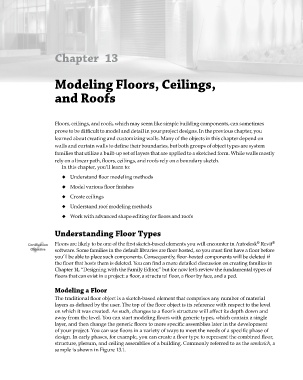Page 573 - Divyank Tyagi
P. 573
Chapter 13
Modeling Floors, Ceilings,
and Roofs
Floors, ceilings, and roofs, which may seem like simple building components, can sometimes
prove to be difficult to model and detail in your project designs. In the previous chapter, you
learned about creating and customizing walls. Many of the objects in this chapter depend on
walls and curtain walls to define their boundaries, but both groups of object types are system
families that utilize a built-up set of layers that are applied to a sketched form. While walls mostly
rely on a linear path, floors, ceilings, and roofs rely on a boundary sketch.
In this chapter, you’ll learn to:
◆ ◆◆ Understand floor modeling methods
◆ ◆◆ Model various floor finishes
◆ ◆◆ Create ceilings
◆ ◆◆ Understand roof modeling methods
◆ ◆◆ Work with advanced shape editing for floors and roofs
Understanding Floor Types
®
®
Certification Floors are likely to be one of the first sketch-based elements you will encounter in Autodesk Revit
Objective software. Some families in the default libraries are floor hosted, so you must first have a floor before
you’ll be able to place such components. Consequently, floor-hosted components will be deleted if
the floor that hosts them is deleted. You can find a more detailed discussion on creating families in
Chapter 14, “Designing with the Family Editor,” but for now let’s review the fundamental types of
floors that can exist in a project: a floor, a structural floor, a floor by face, and a pad.
Modeling a Floor
The traditional floor object is a sketch-based element that comprises any number of material
layers as defined by the user. The top of the floor object is its reference with respect to the level
on which it was created. As such, changes to a floor’s structure will affect its depth down and
away from the level. You can start modeling floors with generic types, which contain a single
layer, and then change the generic floors to more specific assemblies later in the development
of your project. You can use floors in a variety of ways to meet the needs of a specific phase of
design. In early phases, for example, you can create a floor type to represent the combined floor,
structure, plenum, and ceiling assemblies of a building. Commonly referred to as the sandwich, a
sample is shown in Figure 13.1.
c13.indd 539 05-05-2014 16:57:07

